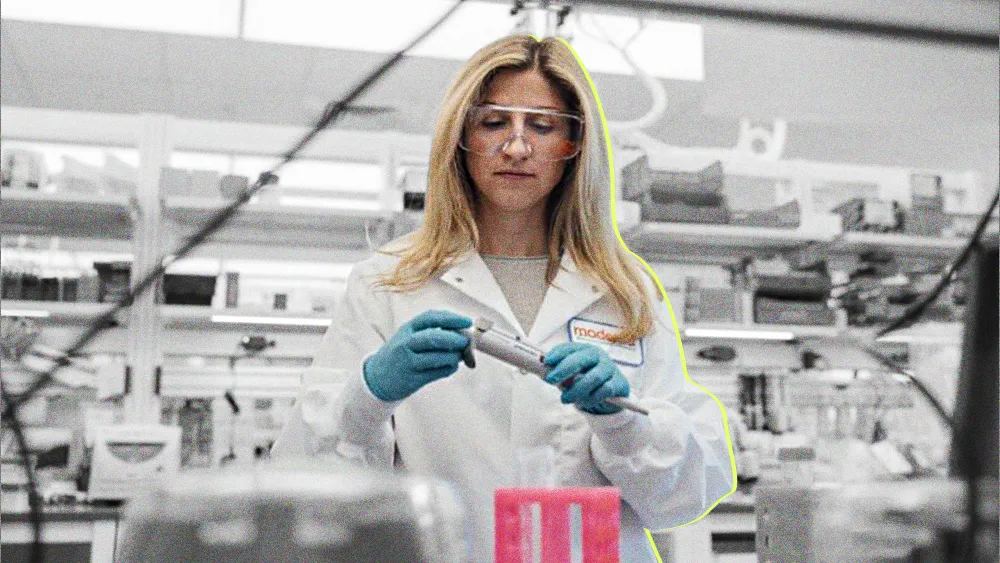
Moderna’s HR/IT merger exemplifies AI’s transition from a product to a peer in organizational structures.
TrustMe.ai’s Larry Chao discusses the importance of rethinking work division between humans and AI.
Knowledge graphs and AI code watermarking could enhance transparency and facilitate AI’s ROI measurement.
The rise of Chief AI Officers and HR-IT mergers indicates a significant industry shift towards integrated work models.

AI in the workplace is becoming less of a product, more of a peer. It’s time org charts caught up, and Moderna’s recent integration of its HR and IT departments is leading the charge.
Helping make sense of this shift is Larry Chao, Founding Chief Strategy & Operations Officer at TrustMe.ai, a security and governance startup. He’s helping companies rethink what collaboration, oversight, and structure look like when AI joins the team.
Tool to teammate: “These AI agents are almost like full-time employees in the market,” says Chao. “That’s why it makes sense now that companies like Moderna are putting the technology team underneath the HR team, because the tools and the people are almost like peers in the organization.”
As this technology continues to improve, he explains, “AI doesn’t necessarily need to be tethered to a developer. Instead, it’s sitting alongside the developer as a colleague.” That shift is prompting companies like Moderna to rethink how work gets divided, adopting work planning strategies to decide which tasks belong to humans and which to machines. It’s a structural rethink that treats AI not as support, but as workforce.
Measuring the invisible: As AI moves from code to colleague, organizations face a tough question: how do you measure its value? Chao advocates for building knowledge graphs to map AI’s contributions alongside engineers, a way to bring clarity to what’s often a murky ROI. “The ROI hasn’t been there,” he says. “The companies are spending millions and millions of dollars, but either the technology isn’t quite there or they aren’t using it quite right. It doesn’t have that payoff.”
That lack of payoff makes transparency critical. “How can you provide ‘explainability’ into what’s going on?” Chao asks. One fix, he suggests, is “watermarking” AI-generated code, making it easier to trace AI’s role and hold it accountable as part of the team.

Changing chiefs: Moderna’s organizational shakeup is part of a broader trend. “We’re starting to see CISOs becoming particularly important,” says Chao, noting that some CISOs have even gained oversight of CTOs. Now, similar shifts are happening with AI. Companies are appointing Chief AI Officers and merging HR with IT to create more agile “flow of work” models in a move that echoes Moderna’s playbook and signals a wider industry reset.
Steer the ship: For companies building around AI, Chao is clear: “It’s really important to do it as top-down as possible.” That means leadership needs to set the direction early with “a really strong mandate that outlines the guidelines in terms of what tools to use, how to use them, and how to track it.” While he acknowledges the path isn’t fully mapped—”I don’t know if there is one model that is clear”—he adds, “but I do think that experiments like what Moderna is doing make a lot of sense.”
Moderna’s HR/IT merger exemplifies AI’s transition from a product to a peer in organizational structures.
TrustMe.ai’s Larry Chao discusses the importance of rethinking work division between humans and AI.
Knowledge graphs and AI code watermarking could enhance transparency and facilitate AI’s ROI measurement.
The rise of Chief AI Officers and HR-IT mergers indicates a significant industry shift towards integrated work models.

TrustMe.ai

AI in the workplace is becoming less of a product, more of a peer. It’s time org charts caught up, and Moderna’s recent integration of its HR and IT departments is leading the charge.
Helping make sense of this shift is Larry Chao, Founding Chief Strategy & Operations Officer at TrustMe.ai, a security and governance startup. He’s helping companies rethink what collaboration, oversight, and structure look like when AI joins the team.
Tool to teammate: “These AI agents are almost like full-time employees in the market,” says Chao. “That’s why it makes sense now that companies like Moderna are putting the technology team underneath the HR team, because the tools and the people are almost like peers in the organization.”
As this technology continues to improve, he explains, “AI doesn’t necessarily need to be tethered to a developer. Instead, it’s sitting alongside the developer as a colleague.” That shift is prompting companies like Moderna to rethink how work gets divided, adopting work planning strategies to decide which tasks belong to humans and which to machines. It’s a structural rethink that treats AI not as support, but as workforce.
Measuring the invisible: As AI moves from code to colleague, organizations face a tough question: how do you measure its value? Chao advocates for building knowledge graphs to map AI’s contributions alongside engineers, a way to bring clarity to what’s often a murky ROI. “The ROI hasn’t been there,” he says. “The companies are spending millions and millions of dollars, but either the technology isn’t quite there or they aren’t using it quite right. It doesn’t have that payoff.”
That lack of payoff makes transparency critical. “How can you provide ‘explainability’ into what’s going on?” Chao asks. One fix, he suggests, is “watermarking” AI-generated code, making it easier to trace AI’s role and hold it accountable as part of the team.

TrustMe.ai

Changing chiefs: Moderna’s organizational shakeup is part of a broader trend. “We’re starting to see CISOs becoming particularly important,” says Chao, noting that some CISOs have even gained oversight of CTOs. Now, similar shifts are happening with AI. Companies are appointing Chief AI Officers and merging HR with IT to create more agile “flow of work” models in a move that echoes Moderna’s playbook and signals a wider industry reset.
Steer the ship: For companies building around AI, Chao is clear: “It’s really important to do it as top-down as possible.” That means leadership needs to set the direction early with “a really strong mandate that outlines the guidelines in terms of what tools to use, how to use them, and how to track it.” While he acknowledges the path isn’t fully mapped—”I don’t know if there is one model that is clear”—he adds, “but I do think that experiments like what Moderna is doing make a lot of sense.”
© 2025 Bamboo HR LLC. All Rights Reserved. BambooHR® is a registered trademark of Bamboo HR LLC